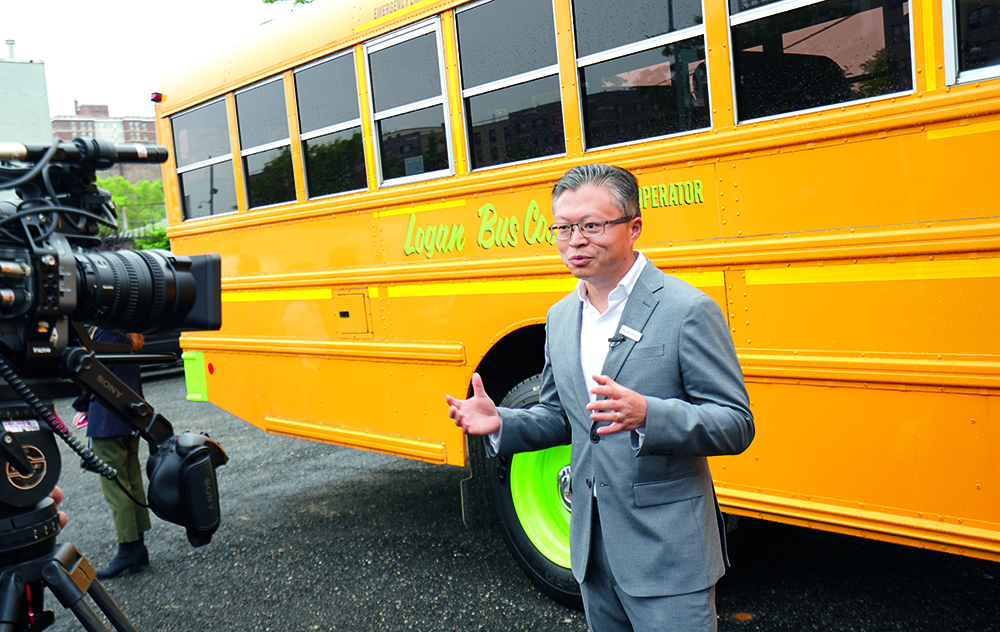Buses, especially school buses, represent a perfect use case for bidirectional charging. When the buses sit idle, they can earn money by providing demand response (DR) services for the local utility. This is one of the services that fleet charging specialist AMPLY Power provides, and as CEO Vic Shao told
Charged in a recent interview, it can offer a revenue source that can offset part of the up-front cost of the vehicles.
“We tell the school district, whenever your drivers get back, just plug in the buses. They’re not going to energize right away, but when they’re needed the next morning, when you need to drive the routes, then these buses are going to be charged up, ready to go,” said Shao. “So, from the time that they plug in the buses—let’s say 4 or 5 pm—until the next morning when they need to operate, we do a few things. We sequentially charge them as needed, or during the time when energy cost is lowest, when the demand spike in the building is reduced. Whenever there’s a dip in the power requirements of the building, we use that to charge up the buses opportunistically, while still meeting obligations that our vehicles will be charged the next day.”
“Second thing that we do is, we enroll the customer in grid services and demand-response applications. School buses are actually a perfect case for this. They are usually back and plugged in by the time that the grid really needs that capacity—the 4-to-9-pm window in California in the summertime is when energy is the most expensive. The grid is spiking during that period of time, and it just so happens that all the buses are plugged in and available, so the time-of-day use case is very strongly aligned with school buses.”

AMPLY is already doing this on at least one project, with Logan Bus, the largest school bus operator in New York City, which operates a fleet of 2,500 buses. “We deployed a very small portion of their fleet just as a start, and on that project, we’re tied in with a DR aggregator called CPower, which is going to be dispatching DR for us on that project,” Shao told us.
We can dispatch power from the bus battery to serve the building, to reduce the overall net draw from the grid, but it’s not pumping power back onto the grid.
“We have to guarantee a capacity at a certain time of the day
,” Shao explains. “The utilities in Con Edison’s territory, in New York City, they typically have 20 or so demand response events, maybe 30 DR events a year in the summer months. So, you enroll in these programs, you get a day-ahead notice for the event, and you have to allocate certain hours, 3 or 4 hours at a time, when these assets are going to be available and can be used for demand response purposes.”
Technically speaking, this is not an application of V2G (vehicle-to-grid), but V2B (vehicle-to-building). “Demand response is not pumping power back onto the grid—it’s just that the building load is reduced. We can dispatch power from the bus battery to serve the building, to reduce the overall net draw from the grid, but it’s not pumping power back onto the grid,” Shao explains.
Are there any true V2G projects underway now, or is that still in the distant future? “It’s not in a distant future,” says Shao. “In fact, the DR is just the first phase of the Logan Bus project. The hardware set that is in use at Logan Bus is V2G-capable. Right now we’re not doing V2G, but it’s a demonstration that we can do in the coming months. And I use the word demonstration very carefully here, because it requires participation, not just from AMPLY or Logan Bus, but Con Edison has to be on board for that demonstration in order to make this work. The utility has to be involved, because when you pump power back onto the grid, it needs to be very carefully thought through.”
V2G is very much in a demonstration phase right now. There are no production V2G programs out there in existence, but the equipment that we have deployed is capable.
V2G is analogous to solar net metering. “When you spin the meter backwards, when you push power back onto the grid, in Con Edison’s territory, there are network protectors in the distribution lines. When you see a reverse power flow, those network protectors will trip so that it’s not endangering the equipment. It requires participation from Con Edison for the demonstration, so that we’re not endangering the utility assets, so V2G is very much in a demonstration phase right now. There are no production V2G programs out there in existence, but the equipment that we have deployed is capable.”
Source: AMPLY Power
